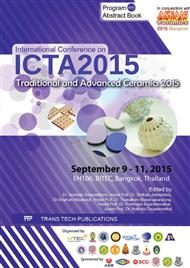p.179
p.187
p.194
p.200
p.206
p.212
p.218
p.224
p.230
The Effect of SiO2, TiO2, and B2O3 on the Crystallization of Glass-Ceramics Glaze Properties
Abstract:
The feasibility of developing glass-ceramic glaze in the system KNaO-CaO-MgO-ZnO with a variation in the composition of SiO2, TiO2, and B2O3 was studied. The SiO2, TiO2, and B2O3 were varied in the amount of 2.25-1.50, 0.001-0.10, and 0-0.1 molar equivalents respectively. The samples were one fired at 1180°C or double fired by reheat at the crystallization temperature for 10 minutes. The gloss, sintering behavior, phase, microstucture, and hardness, and were examined by glossmeter, side-view hot stage microscope, X-ray diffraction, SEM, and Vickers hardness respectively. The results showed the importance effect of SiO2, TiO2, and B2O3 on the glaze crystallization ability and its properties. At the fix value of Al2O3 at 0.24 molar equivalents and with the 0.001-0.10 molar equivalents of TiO2, lower the SiO2 content to 1.50 molar equivalents increased the glaze crystallization potential. An increase in the B2O3 to 0.1 molar equivalents suppressed the potential of glaze crystallization. The phases of samples were amorphous or composed of silicon dioxide and diopside as the main phases depending on the glaze composition and the firing history. In this study, the glaze appearances transparent to opaque and varied from gloss to matte with the specular gloss values between 23-100 GU. All samples appeared to have high Vickers hardness value in the range of 553-644. The crystallization decreased the gloss but increased the hardness value for the 2.25 molar equivalents SiO2 glaze. Finally, a composition with high hardness and high gloss was identified and its properties was also presented. These results suggested the limitation and the potential for applying this glass-ceramic glaze system to industry applications.
Info:
Periodical:
Pages:
206-211
Citation:
Online since:
May 2016
Keywords:
Price:
Сopyright:
© 2016 Trans Tech Publications Ltd. All Rights Reserved
Share:
Citation:


